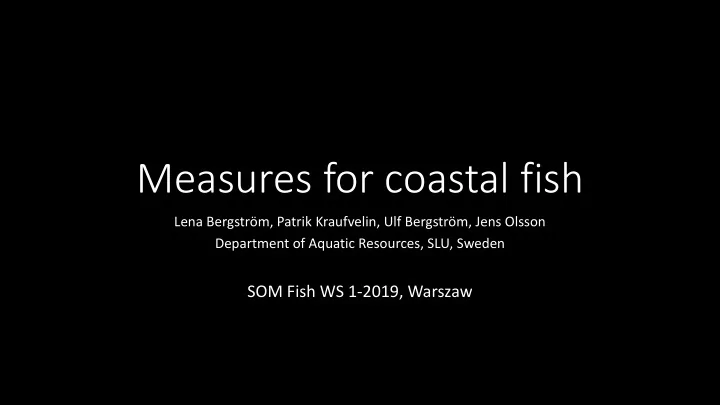

Measures for coastal fish Lena Bergström, Patrik Kraufvelin, Ulf Bergström, Jens Olsson Department of Aquatic Resources, SLU, Sweden SOM Fish WS 1-2019, Warszaw
Measu sures f s for c coastal f fish sh t to reduce mort ortali ality Measure name Link to major pressures Scientific support for effectiveness for fish in the Baltic Sea Permanent fisheries closures Fishing Yes (no-take areas) Partial fisheries closures Fishing Yes Regulation of fishing gears Fishing Yes and catch Source: HELCOM Thematic Assessment of Coastal Fish 2018 (HELCOM Fish Pro III)
Mea easures es f for c coastal f fish to support t producti tivity Measure name Link to major pressures Scientific support for effectiveness for fish in the Baltic Sea Stocking of young fish Fishing No Nutrient reduction Eutrophication No Habitat protection Physical exploitation Yes Habitat restoration (see next Physical exploitation, Yes, but mainly local effects slide) Eutrophication Reduction of harzardous Input of hazardous substances No substances Biomanipulation (extraction Fishing, Eutrophication No of e.g. Cyprinids/sticklebacks) Source: HELCOM Thematic Assessment of Coastal Fish 2018 (HELCOM Fish Pro III)
Supporting the productivity of fish
Restor oration on me measures t that ma may s suppor ort p productivity of coastal al f fish Measure name Link to major pressures Scientific support for effectiveness for fish in BS Restoring eelgrass and Eutrophication, Physical No freshwater angiosperms exploitation Restoring unvegetated soft Eutrophication, Physical No bottoms exploitation Restoring hard bottom Eutrophication No macroalgae Restoring blue mussel reefs Eutrophication No and blue mussel bottoms Restoring stony reefs, placing Physical exploitation, Yes out artificial reefs Eutrophication Restoring wetlands (pike and Agriculture and forestry, Food Yes perch factories) web measures, Physical exploitation, Eutrophication Source: Kraufvelin et al. In prep.
Mortality factors of fish
Gener eneral t trends ends i in n Sweden eden f for coast stal fish sh and its ts morta tality fact ctors Perch Pike Pikeperch Commercial fisheries Recreational fisheries Cormorant Grey seal
Statements based on current studies • Recreational fishing has strong effects on all three species Fisheries • Areas closed to fishing have 2-5 times higher abundances. Quick responses Cormorant • May locally decrease predator populations, especially of perch Grey seal • Uncertain estimates. Pike seems prone to seal predation The total picture affects the efficiency of fisheries regulation measures
Evidences? Methods for understanding mortality factors A. Comparison of fish removals B. Population modelling C. Experimental studies • Large-scale manipulations, e.g no-take areas • Natural experiments
A. Comparison of fish removals Based on fisheries statistics, and abundance + diet data Estimates per ICES SD, for all important species Fish removals per year Recr. fishing Comm. fishing Cormorant Grey seal Perch Pike Source: Hansson et al 2018. ICES Journal of Marine Science 75
B. Population modelling How do seals and cormorants affect fish stocks? - Heated debate. Strong opinions - Little evidence - Weak interest from management Parametrisation is difficult Conclusions on population effects differ between studies
C. Experimental studies Case 1: Removal of fisheries with pr preda edators pr pres esen ent • No-take zone established in 2010 • Test fishing in 2009-2016 in no-take zone and reference area • Estimation of predator removals
Effects of fishing and predation Fishing: strong increase in no-take area Seal predation: negative effect on pike, perhaps also perch Cormorant predation: negative effect on perch Grey seal Increase in no-take area No increase, possibly due to predation Initial increase, then decrease after seal came in Source: Bergström U et al In prep.
C. Experimental studies Case 2: Removal of fisheries + addition of predators • No-take zone established already in 1980 • Test fishing in 2005, 2013 and 2018 in no-take area and reference • Increasing seal abundances during period • Cormorant colony since 2014
Effects of fishing and predation Fishing: 2-4 times higher abundance in no-take area Seal predation decrease in pike Cormorant + seal predation decrease in perch Perch Pike Seal + cormorant 30 1,0 25 Seal 0,8 20 0,6 CPUE 15 0,4 10 No-take 0,2 5 Reference 0,0 0 2005 2013 2018 2005 2013 2018 Source: Bergström U et al In prep.
Other effect sizes: Comparing effects of fishing and eutrophication (A) Differences in species compositon Increasing nutrient enrichment No-take area close to reference area Interannual variation in a referecence area Source: Bergström L et al 2019 Ambio
Other effect sizes: Comparing effects of fishing and eutrophication (B) Differences in species Biomasses Piscivores Non-piscivores Source: Bergström L et al 2019 Ambio
Conclusions No-take areas are valuable management measures to restore fish Fishing, cormorants and seals all contribute to declines in coastal predatory fish. The impact of cormorants and seals is increasing To restore fish populations, we have to manage both fisheries and top predators
Recommend
More recommend